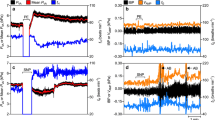Abstract
Prostaglandin E2 (PGE2) injection caused an initial decrease in heart rate (HR) (55%), cardiac output (QC) (55%), ventral (VAP, 40%) and dorsal (DAP, 60%) aortic pressures, associated with a marked gill vasoconstriction (100%) and a systemic vasodilation (30%) while cardiac stroke volume (CSV) remained unchanged. It was followed by a progressive recovery of HR, DAP, and vascular resistances to control values while VAP, QC, and CSV significantly increased (20%, 40%, and 40%, respectively). Bradycardia was abolished either by atropine treatment or bilateral section of the cardiac vagus, suggesting that bradycardia could be the consequence of a vagal mechanism triggered by a central action of PGE2. The increase in QC is due to the increase in CSV, which suggests a positive inotropic action of PGE2. Infusion with PGE2 (10−9 to 10−5 mol · l−1) did not cause any significant effect on the branchial vasculature in vitro, but when the preparation was pre-treated with adrenaline (10−8 mol · l−4), a dose-related vasoconstrictory response to PGE2 (10−9 to 10−5 mol · l−1) occurred. A significant rise (25%) in gill vascular resistance was observed in vivo after treatment with the β-blocker propranolol (2.0 mg · kg−1), suggesting the existence of a vasodilatory β-adrenergic control of the branchial vasculature. PGE2 caused an apnea followed by a simultaneous tachypnea (50%) and decrease in ventilatory amplitude (40%). The resulting decrease in ventilatory water flow (Qw) was accompanied by a fall in arterial O2 tension (Pa O 2). Under steady Qw in curarized eels, an initial fall in Pa O 2 was still observed during the PGE2-induced gill vasoconstriction. It is concluded that PGE2 could play a role in the regulation of gas exchanges and blood circulation in particular environmental conditions which require an impairment of gill respiration and a redistribution of blood to the benefit of the systemic vascular bed.
Similar content being viewed by others
Author information
Authors and Affiliations
Additional information
Accepted: 3 June 1997
Rights and permissions
About this article
Cite this article
Janvier, JJ. Cardio-vascular and ventilatory effects of prostaglandin E2 in the European eel Anguilla anguilla. J Comp Physiol B 167, 517–526 (1997). https://doi.org/10.1007/s003600050104
Issue Date:
DOI: https://doi.org/10.1007/s003600050104




